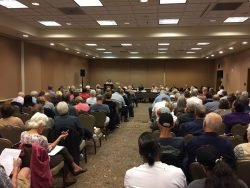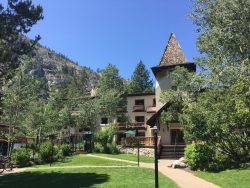Most people know that fall and football go together. But only a handful know that fall is also election season at timeshare resorts across the country, where very few people vote and, in all likelihood, even fewer care about the outcomes. All owners generally care about is #1 reservations and #2 maintenance fees. HOA board member elections probably rank way down there, like #41.
Not this fall. While thousands of timeshare owners worry about their vacations and resorts in hurricane-ravaged areas of the country, others are paying attention to all the home-grown issues at their own resort.
In fact, from California to Kauai, Idaho to Orlando, RedWeek keeps hearing from timeshare owners who are getting more involved in the governance of their resorts. At a handful, owners are starting to organize themselves to take greater control of management issues. At others, owners are simply getting rid of board members who have overstayed their welcome — and failed to fulfill their fiduciary duties to make the best decisions on behalf of all owners.
In this spotlight on legacy resorts, we will focus on two aging but desirable timeshares where owners banded together, in dramatic fashion, to prevent their resort from being taken over, or at least controlled by, major timeshare companies.
Both happen to occupy prime real estate around Lake Tahoe, which is a hotbed of timeshare resorts, old and new. Marriott, Diamond, Wyndham, Hyatt, and Welk have major presences and appear to be looking for more. It’s also a smorgasbord of older independent resorts facing major renovations, rising defaults, plus rental and resale issues that not only threaten their economic existence, but make them ripe takeover targets for well-financed timeshare companies or investor groups. Some of these aging resorts, according to real estate folks in the area, will eventually fall into the hands of new developers who will invest and re-purpose the timeshare into a modern hotel or other business that is more profitable than a struggling timeshare.
The rest of this blog is about two Tahoe resorts caught in the middle of this struggle. Simply put, they are just trying to stay alive.
PART I: Tahoe Beach and Ski Club Owners Re-elect Board Member Who Cast Key Vote Against Diamond’s Potential Takeover, But Tensions Remain
SOUTH LAKE TAHOE, CA — Sedric Ketchum, the swing vote on a divided board that decided to reject Diamond Resort’s takeover moves three years ago, won re-election to another term in September, but it wasn’t easy. Recovering from serious surgery, Ketchum barely made it through the obligatory candidate forum, then retired to his room at Tahoe Beach and Ski Club as soon as the votes were cast.

Sedric Ketchum won re-election to Tahoe Beach and Ski Club Board despite a no-confidence vote from Diamond Resorts
He won re-election handily, despite a defection from one of his fellow board members and a decision by Diamond, which owns 23 percent of all timeshares at the beachfront timeshare, to vote for no one. Right up until the vote was announced, no one knew what Diamond planned. The company wanted to dump Ketchum, but couldn’t find a suitable candidate to back, so it sat on its votes.

Tahoe Beach and Ski Board President Al Fong urges owners to stay vigilant against Diamond.
Not exactly a vote of confidence for Ketchum, who was key to the board’s rejection of Diamond’s perceived takeover bid in 2014. Diamond played cat-and-mouse with the owners in 2017, just as it did in 2016 (when it was also declined to announce its intentions).
In months leading up to the vote, Diamond asked first-year board member Bill Costa to find a replacement for Ketchum, but his recruitment efforts fell short. (Most owners had no knowledge of Costa’s activities, and they also seemed to like Ketchum, so why vote against him?) During the past year, Costa also worked on his own to broker a deal between TBSC and Diamond to settle litigation that Diamond initiated in 2015. So it was not much of a surprise that Costa also worked with Diamond on a possible alternative to Ketchum.
We interviewed Ketchum and Costa about their split. It seems to be more personal than professional, so we’ll leave it at that. We also interviewed other owners who were brought into the schism, including one owner who was recruited to oppose Ketchum, but they seemed puzzled about it as well.
Ultimately, the tensions within the board did not matter. With more than 175 owners huddled together under a beachfront revival tent on a cold, blue sky day, Ketchum collected 1,985 votes, including 39 voted by the board (Costa abstained). Diamond had 1,750 votes, but kept them in the corporation’s pocket for another day. No Diamond representative even showed up to address the crowd — a far cry from a year ago, when a Diamond VP rankled the audience with a tone-deaf explanation of the benefits of Diamond’s presence and points-and-trust program.
“Never take your ownership for granted,” warned a somber but jubilant Board President Al Fong after the vote. “Diamond is a sleeping giant. They are waiting for you to fall asleep.”
Diamond started buying foreclosed TBSC units at auction several years ago as part of its bid to increase its presence in South Lake Tahoe, where it already operates several timeshares, including the majestic Lake Tahoe Vacation Resort, which is right next door to Tahoe Beach and Ski Club. Diamond was well on the way to becoming the dominant majority owner of TBSC when the board, awakening like a slumbering giant , refused to accept Diamond’s purchase of several hundred intervals in December 2014. That HOA action triggered threatening letters from Diamond, and eventually a lawsuit — which continues to this day.
Since then, the TBSC-Diamond story has devolved into an “us-against-them” fight where owners rallied to elect board members, in three straight years, who are dedicated to keeping Diamond at bay. The anti-Diamond board members ran annual grassroots campaigns, with beachfront owner-update meetings on Mondays and Thursdays, to energize owners about the perceived threat that Diamond, one of the largest and most acquisitive timeshare companies in the world, posed to their traditional legacy resort. So far, they’ve succeeded in warding off the giant.
Barring a major change in direction, next year’s HOA election will put two more anti-Diamond board members onto the same hot seat that Ketchum just occupied. President Fong and Treasurer Jake Bercu, Diamond’s most vocal critics, will face re-election while promoting the dividends of maintaining the independence of Tahoe Beach and Ski Club. No matter what else happens, they already know that at least 23 percent of the owners — Diamond — will vote against them.
Diamond is not the only major timeshare company seeking a larger footprint in Lake Tahoe. Wyndham, the largest timeshare company in the world, is also seeking a bigger stake. But its plans for a smooth transition — takeover or otherwise — just ran into an owner revolt at the Olympic Village Inn.
‘PART II: Gang of Four’ Owners at Olympic Village Inn Fire Longtime HOA Board Members who Hired Wyndham to Run Resort in 2016
- Rebels promise to review Wyndham’s contract and end foreclosure agreement
SQUAW VALLEY, CA — A ballot box rebellion at Olympic Village Inn (OVI), a bucolic Alpine resort in North Lake Tahoe, triggered a palace revolt in October that resulted in the ouster of four HOA board members who agreed, one year ago, to turn the resort’s management and all defaulted units over to the Wyndham timeshare conglomerate.

Standing Room Only at annual board election for Olympic Village Inn in Squaw Valley.
Gang of Four rebels routed incumbents who hired Wyndham to manage resort.
In a record turnout on a spectacular fall-colors October Saturday, the so-called “Gang of Four,” led by a hard-nosed and proudly profane prosecutor named Bob Bone, dumped four longtime board members who, despite having their own misgivings about contracting with Wyndham, turned the keys to the resort over to Wyndham’s management company in 2016. Bone and his co-conspirators, all of whom proudly own the Gang of Four appellation that was hung on them by a hostile board member, immediately fired Board President Alan Traenkner — Wyndham’s primary champion — and board counselor Joan Wright. They also agreed to dismiss a legal fight, launched by Bone months ago when he was just a fledgling activist, to force the HOA to disclose owner rosters (including emails) to members for campaign purposes.
Elected in a landslide, the new majority at the seven-member HOA is composed of Bone, who replaces Traenkner as president, and fellow activists Julie Feldman, Sandy Farrow and Greg Rankin. They replace former board members Connie Gast, Ron Spiller, Wayne Hooper and Mike Harper (who also opposed Wyndham’s hiring but ran afoul of Bone months ago). Holdover board member and CFO Brad Hartman also opposed Wyndham’s contract, so he could be considered a potential “Gang of Five” member in the future. The other holdover, Larry Grace, faces the same fate as Traenkner — obscurity at the end of the HOA bench. In many ways, the election represents a generational pivot as well as a policy change. In with the new, out with the older.


New Board President Bob Bone (top) led a multimedia campaign to oust four longtime board members.
Bone’s first move was to fire former Board President and Wyndham advocate Alan Traenkner (bottom)
When the results were announced, the 200 OVI members who shoe-horned into an overfull hotel conference room erupted in applause and shouts — as if their favorite football team had just scored a touchdown. A record 58 percent of all OVI members voted (in the industry, 20 percent would be normal, 30 percent a milestone). Bone got 2,017 votes, followed by Rankin, 1,997, Farrow, 1,992, and Feldman, 1,818. The incumbents received 139 to 149 votes each, plus 436 votes cast for each incumbent by Wyndham.
Afterwards, the defeated incumbents — all longtime board members — exited muttering while Traenkner took stock, shaken if not stricken by his landslide loss in an election that was a total referendum on his move to hire Wyndham. Then with a wave, he was gone.
“I’m not the Gang of Four,” Traenkner said, his face flushed. “My job is to make the transition as smooth as possible. We represent the whole association. That’s important for people to know.”
Several Wyndham executives attended the SRO meeting, wearing casual business outfits and frowns. They said afterwards that they would work with the new board to resolve all issues of concern. But their furrowed brows told the story: Wyndham’s experiment with OVI was going south.
Moral of this Election is: Don’t Mess with Bonus Time — or Bob Bone)
Olympic Village Inn, set in an elbow pasture at the base of Squaw Valley’s majestic ski area, is probably one of the last places one would expect to morph into a launching pad for timeshare-owner activism. The resort came to fame decades ago as the US host of world-class skiers and other Winter Olympians in 1960. While the Lake Tahoe resort area grew, OVI stayed the same: laid-back and serene, it was a tiny 90-unit timeshare getaway with 3,300 owners and 4,590 intervals that catered to skiing families from the Bay Area. OVI was stable for years; its financials were OK, maintenance fees stayed low ($800) and default rates (from owners) hovered in the single digits. But then things changed.
In April 2015, Traenkner and the OVI board hit a wall: the resort’s longtime general manager (who had taken care of everything for 32 years, according to Traenkner) announced he would retire in July 2016. That triggered a search for replacement that forced the board to look outside its local circle of associates. Traenkner attended Timeshare Board Members Association meetings to meet and interview management companies.
Traenkner and other board members talked to several companies, then picked Wyndham, which offered a management deal that no other company came close to matching: Wyndham would spend $1.25 million on renovations, pay $10 for 253 HOA-owned units (and pay all of the maintenance fees for those units), launch a rental and resale program, and fold OVI into Wyndham’s global reservation system. In addition to the management contract, Wyndham, a timeshare giant with worldwide experience managing 200 resorts, offered to take responsibility for all future OVI units that go into default (thereby guaranteeing those maintenance fee payments as well). No surprise, the board said YES. As a result, Wyndham took over in August 2016.
Traenkner said recently that he thought he was doing OVI members a great service by hiring Wyndham. Unfortunately for him and his fellow board members, it all went awry.
Olympic Village Inn on a perfect summer day at base of Squaw Valley ski area.
At first glance, this sweetheart deal appeared to take care of all OVI problems: Wyndham would run all resort operations, pay up all late dues, plus guarantee payment of maintenance fees on all future defaulted units. In return for its oversight, Wyndham would gradually acquire an increasing share of the intervals at OVI — and, potentially, gain voting control oF the board. As of this writing, according to Traenkner, Wyndham owns 436 intervals, or approximately 10 percent of OVI. (Wyndham executives say the company has no plans to take over the board or the resort. At other comparable legacy resorts around the world, Wyndham has used its ownership stake to install corporate execs on the HOA board to protect the company’s investment.)
The deal might have worked out famously, in fact, if Wyndham had delivered a gold-medal performance during the transition period. Instead, it stumbled, repeatedly. Wyndham installed a new GM with no timeshare experience who, for various reasons, irritated owners and board members, including Traenkner, Wyndham’s champion. Over the next year, Wyndham installed three additional GM’s or interim GM’s. The company also fired most of the housekeeping staffers because they were not legal residents. Wyndham’s reservation team also took over, which surprised owners who knew nothing about the changes. Owners used to calling OVI at Squaw Valley suddenly found themselves talking to Wyndham operators back East.
While Wyndham had some (predictable) hiccups implementing changes, the OVI board overlooked a key issue, and it turned into a fatal mistake: The board failed to tell owners about Wyndham until after the deal was done. Bone, for example, knew nothing about Wyndham’s presence until November 2016, when he tried to use his “bonus time” privileges to reserve rooms at a discount so he could bring his ski-oriented family to the resort on winter weekends. Instead of securing an easy last-minute weekend reservation, Bone discovered, from a Wyndham operator, that the bonus time rules had changed.
That innocuous first contact with Wyndham’s presence at OVI started a chain reaction that, over months, led to the revolt that deposed four OVI board members, including three who approved of the Wyndham deal. Here’s how it all fell apart. Bone, a very outspoken lawyer from Santa Rosa, complained to Traenkner and other board members about the bonus time changes, then started digging into other things that were shifting at OVI — including the unannounced staffing changes that left the housekeeping team in shambles. Bone, contentious by nature, also had conflicts with the new GM and other Wyndham corporate executives. Over time, an exasperated Bone mounted a very public campaign against the board based on what he perceived as the board’s negligence and Wyndham’s negative presence at the resort. His efforts not only stirred up other owners, but helped persuade the board to abort the HOA-default foreclosure agreement in March. In June, Bone successfully sued the board in small claims court to secure the membership roster so he could communicate his displeasure about the board and Wyndham with other owners. Instead of turning over the rosters, the board fought the lawsuit.
The campaign got personal in a hurry. Bone called out Traenkner on many occasions and offended other board members as well. He accused the board of election fraud and sent a stream of combative emails demanding documents and explanations of board policy. At the same time, Bone’s “gang” launched a phone bank to contact owners and created a “SaveOVI.org”website where they posted information about the board’s actions, attacked Wyndham’s motives and generated support from owners. The outreach campaign was critical, because Traenkner and the incumbent board never responded in kind. (In fact, after the vote, Traenkner lamented that he never mounted much of a campaign and, worse, conceded having no insight about why owners voted against him.)
“Thanks to this board, the resort is falling apart,” said the hyperbolic Bone, an owner since 2012 who primarily uses his timeshare for bonus time. “Wyndham is trying to run the resort into the ground for the sake of consuming it. But I don’t really view Wyndham as an evil empire. I’m more concerned about HOA boards that are filled with individuals who don’t read documents when they are charged with the responsibility of protecting a public trust.”
Greg Rankin, a Gang of Four member and original sales manager at OVI, said he decided to run because “the board made a terrible mistake in selecting Wyndham. And, despite overwhelming evidence over the past year,…they refuse to admit and acknowledge their mistake. The board’s unwillingness to provide meaningful oversight of Wyndham…has result in rapid deterioration of the property and a significant decline in both the level of service and overall quality of experience our owners have enjoyed over three decades.”
Traenkner, interviewed several times about the transition over the past year, is understandably defensive about hiring Wyndham. “They put money into the association to help with remodeling, so we were able to reduce dues from $840 to $800,” he said. “And their rental program has been good.” Still, he admitted having numerous “startup issues” with Wyndham that created consternation on the board and within the membership.
Wyndham Very Experienced Running Resorts, but Stumbled at Olympic Village Inn
We interviewed two senior vice presidents at Wyndham about the controversy. They conceded making some mistakes during the transition, but otherwise defended their contract and intentions at OVI. They said Wyndham, which now owns an estimated 10 percent of the intervals OVI (436 intervals) has no plan to take over the board or the resort. In separate interviews over many months, Traenkner and other board members also voiced dissatisfaction with Wyndham’s first GM and other aspects of Wyndham’s transition, but otherwise defended their decision to bring in a major company that, in their eyes, would ensure the longterm financial stability of OVI.
Consultants familiar with the timeshare industry say there are many ailing legacy resorts in the US that probably need a Wyndham or similarly equipped timeshare-and-management company to advise boards and run resorts. But OVI, they said, did not need Wyndham, because its financials were in generally good shape (thanks to the work of the former GM, who appeared to handle everything.) What OVI needed, these consultants said, was a robust rental and resales program to monetize units that were going into default due to the resort’s aging owner base.
In a post-election moment of calm, Bone said: “We ran on a simple pledge of transparency and openness. We also pledged that we would immediately engage in oversight of the new General Manager Wyndham Resort Development Corporation. We promised our fellow members that we would not do what the prior Board did by entering contracts in secret Board meetings where there are no meeting minutes in violation of the resort governing documents and the law.”
Bone, who contended all along that OVI didn’t need Wyndham, plans to make Wyndham’s management team prove their value — or pack their bags. The company’s management contract comes up for renewal in 2019, unless Bone and company take moves to shred it in the meantime. The 2019 year is also when Bone and the Gang of Four will stand for re-election — and face the same kind of referendum that ended Traenkner’s reign as president in October.
NB: this is not an unusual story; most if not all major developers are collecting deeded-week inventory from legacy resorts, frequently at zero-dollar prices, to replenish inventory for their trust associations, which then re-sell the legacy inventory as points, instead of weeks, for a retail price average of $20,000 or more per week. For the major developers, this is smart business, and it also relieves the financial pressure on legacy resorts, such as OVI, that are losing 100 or more owners per year, every year. Wyndham’s timeshare business, which will be spun off into a stand-alone public company in 2018, reported $2 billion in sales for 2016. It has 900,000 owners and owns or operates 221 timeshare resorts in the US, Canada and the Caribbean. OVI, while extremely important to owners, is just a twinkle in the constellation of Wyndham’s timeshare universe.
What IS unusual about this story is the unprecedented activism of owners at Olympic Village Inn, rank and file timeshare owners who banded together to initiate changes at their resort. We’ll report on the outcomes of their efforts in future installments of ‘Staying’ Alive.’
